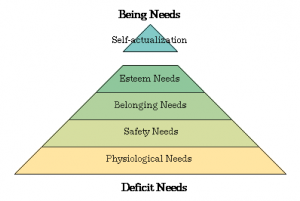This week, I was reading about the psychology of human motivations and decision-making. I’m not a psychologist or sociologist, but it is interesting to consider what motivates those people who opt to move to a continuing care retirement community (CCRC) or other type of senior living community.
Specifically, I was reading about Abraham Maslow, who has been referred to as the father of the humanistic psychology movement. Widely embraced in the early 1960s, humanistic psychology is literally a “human-centered” approach to understanding people’s psyches — a theory that emphasizes the uniqueness of each individual.
The humanistic psychology theory was developed as a counterpoint to Freud’s psychoanalysis principles and Skinner’s behaviorism, which focused primarily on the past and the pathology instead of on the present and the person.
To make a case for his humanistic approach to psychology, Maslow authored a 1943 paper entitled, “A Theory of Human Motivation.” In it, he laid out the details of his research and presented what has come to be called Maslow’s Hierarchy of Needs.
Maslow’s Hierarchy of Needs
 Maslow’s Hierarchy of Needs is comprised of five key elements, which form a pyramid when put into a diagram.
Maslow’s Hierarchy of Needs is comprised of five key elements, which form a pyramid when put into a diagram.
- Forming the base of the pyramid are physiological needs — the most basic things a human being needs to survive like air, water, food, sleep, shelter, clothing, and sex.
- The next layer up on the pyramid is safety needs, which would include physical protection from danger, health, and well-being, as well as economic/financial security.
- The portion of the pyramid above that is love and belonging needs, which encompasses a sense of “fitting in,” family and social relationships, and other community-centric connections.
- Next on the pyramid is esteem needs, which are those all-important sentiments like feeling appreciated, self-esteem and respect, recognition, and freedom.
- Finally, at the pinnacle of the pyramid is self-actualization needs — the sense that you are fulfilling your full potential to be your best self in this life.
>> Related: The Key Difference Between Social Isolation & Loneliness
What motivates people’s decisions
Maslow’s Hierarchy of Needs theory posits that the basic human needs that form the bottom four layers of the pyramid — what Maslow referred to as, “deficit needs” or “d-needs” — must be met before a person can strive for, or even put any energy towards, those aspirational self-actualization needs, which Maslow called “being needs” or “b-needs.”
In short, a person cannot possibly attain their highest goals for a meaningful life until their most fundamental human needs are met. Additionally, when those d-needs that form the bottom portions of the pyramid are unmet, it leads to feelings of anxiety and tension.
As part of his Hierarchy of Needs theory, Maslow also developed the concept of meta-motivation. This refers to the motivations of those people who successfully move beyond their basic needs and are able to constantly strive for self-improvement and betterment. People who are meta-motivated are driven by their b-needs instead of their d-needs.
>> Related: Pre-Crisis vs. Post-Crisis Planning: Confronting Life’s Unknowns
The psychology of a senior living decision
What does all of this have to do with making a senior living decision, you might be thinking? Well, it has a lot to do with it!
In our “I’m Not Ready Yet” blog series, we focused on some of the reasons that people say they are not yet making their move to a CCRC or other type of senior living. For some people, that “not ready” feeling is tied to their emotions around downsizing and having to get rid of “all this stuff.” For others, their hesitation is related to affordability concerns and a fear of running out of money. For still others, they feel like they aren’t “old enough” to live in a CCRC.
The psychology behind all of these hesitations and concerns is worth understanding. There truly are a flurry of different emotions that can be stirred by the prospect of making a senior living move, and they can be closely tied to a person’s motivations for moving.
But I keep coming back to something I read in a whitepaper developed by Morrison Living (formerly Morrison Senior Living), best known for their dining and nutrition services at many senior living communities across the country…
>> Related: For Senior Living Decisions, Are You a Planner, Procrastinator, or Crasher?
The motivations of senior living residents
In 2012, Morrison did a multi-part focus group study on the voice of the so-called “Silent Generation” (people born 1928 – 1945). The researchers explored these seniors’ beliefs, motivations, and priorities.
The third part of this study examined what motivates those seniors who ultimately move to a senior living community — whether that be an independent living community, CCRC, assisted living community, or nursing home.
One excerpt from the Morrison whitepaper on the study really gets to the heart of some of the psychological motivations behind a senior living move:
“There is a difference between what first attracts potential residents to communities and what deeply satisfies them once they live in a community. Focus group participants talked about the appeal of the continuum of care, freedom from home maintenance, and feeling safer and more secure, but ‘I should have moved years ago’ is the most uttered phrase among new residents. The reasons behind that satisfaction include opportunities for personal growth, friendship and community, and newfound freedom that comes with an abundance of stress-free time.”
The whitepaper goes on to cite a 2017 study by research organization ProMatura on senior living resident satisfaction, which found that the quality of daily life in a community is the top factor for those with the highest satisfaction levels. The areas of “daily life” that rated highest were cultural, musical, arts and crafts, and educational opportunities, all of which might be categorized as opportunities for personal growth.
>> Related: In a Good Place: Enjoying Retirement in a CCRC
Stress-free living
Looking at the findings of the Morrison study in combination with the ProMatura resident satisfaction study, the connection between a senior living decision and Maslow’s Hierarchy of Needs becomes much clearer.
Those seniors who make the decision to move to a CCRC are ensuring their “deficit needs” or “d-needs” — shelter, safety, health, interpersonal connections, a sense of freedom, and more (the bottom four layers of the pyramid) — are met. This enables them to instead focus their time and energy on self-actualization at the top of the pyramid — those “being needs” or “b-needs.”
The “opportunities for personal growth” and “newfound freedom that comes with an abundance of stress-free time,” mentioned in the Morrison paper, can enable and motivate a CCRC resident to dedicate time to a beloved hobby or even pursue a new passion. This is the meta-motivation that Maslow described among those who are able to focus on b-needs.
Perhaps it’s a creative endeavor, volunteerism, enjoying time with friends and family, traveling, playing a sport or instrument, or learning a new language. Whatever your goals for personal growth, a CCRC can help you work toward your full potential with their many on- and off-campus activities, as well as that “abundance of stress-free time.”
>> Related: Rediscovering Your Life’s Purpose Later in Retirement
Reaching your full potential
Moving to a senior living community means no more home maintenance. No more trying to figure out what to make for dinner. No more worrying about whether your home’s layout will accommodate any future mobility issues. No more worrying about loneliness or isolation. And moving to a CCRC, with its full continuum of care services, means no more worrying about who will care for you if you should eventually need it.
In short, the peace of mind, security, lifestyle, companionship, and free time afforded by living in a CCRC contributes to the quality of life and level of satisfaction ProMatura noted among senior living residents. And making a move to a CCRC also facilitates those self-actualization growth opportunities found at the top of Maslow’s Hierarchy of Needs pyramid. What could you do with an “abundance of stress-free time”?

FREE Detailed Profile Reports on CCRCs/Life Plan Communities
Search Communities






